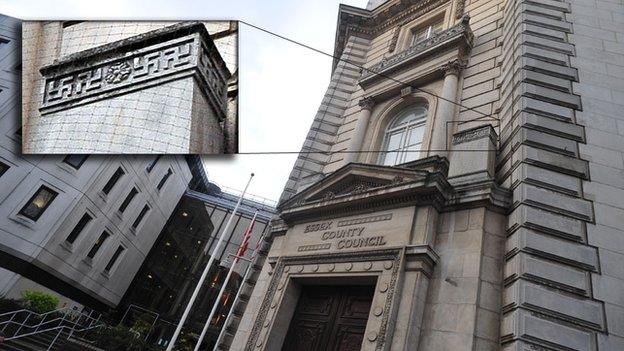Swastika building question put to Essex County Council
- Published

This section of Essex County Council's headquarters was finished in 1939, the year Britain and Nazi Germany went to war
Swastikas carved into a county council building have been branded "potentially offensive and upsetting" by someone demanding to know why they are there.
The carvings on Chelmsford's County Hall, built between 1928 and 1939, were made shortly before World War Two.
But a member of the public has lodged a Freedom of Information request asking why it "was still commissioned given the symbol's negative connotations".
Essex County Council said it would not comment before answering the request.
It is not known whether the council has ever been asked to remove the symbols or whether the authority had ever discussed their presence on the building.
The person requesting the information, who has not been named, said the timing of the swastika symbols "struck me as strange seeing as the Nazi party formed in 1933 and by March 1938 were beginning an invasion into Austria.
"It's potentially offensive and upsetting to those that lost loved ones in the war or those that fought for their country."
But Dr Mark Curteis, curator of social history and art at Chelmsford City Council, said the swastikas on County Hall were "lifted and adapted from previous designs", including those from ancient Greece, where swastikas were used.
"The swastika is still a symbol of peace."
'Imposing quality'
John Hammond, of Chelmsford Civic Society, said he was "mystified" the swastika issue had now been raised.
"If they were going to be removed it would have happened immediately after the war, or during," he said.
"But it is also encouraging to think people are looking at the detail on buildings.
"There's so much out there when you look above the shop window."
According to its English Heritage listing, external, the HQ block bearing the swastikas was built by J Stuart of Portland stone between 1929 and 1939.
English Heritage describes it as having an "imposing external architectural quality".
- Published11 February 2014
- Published21 November 2013
- Published27 October 2013
- Published25 July 2012